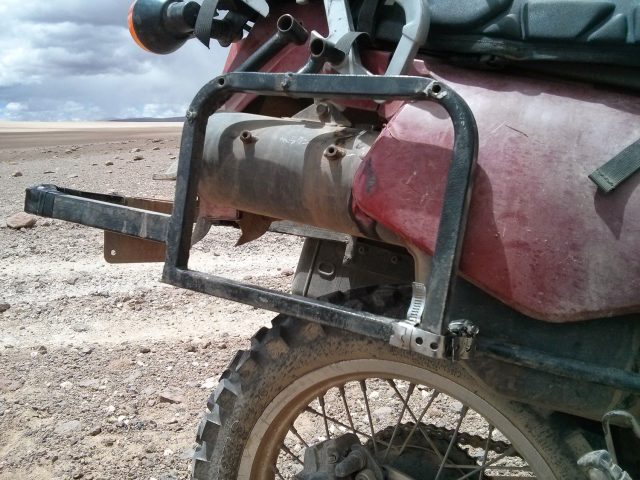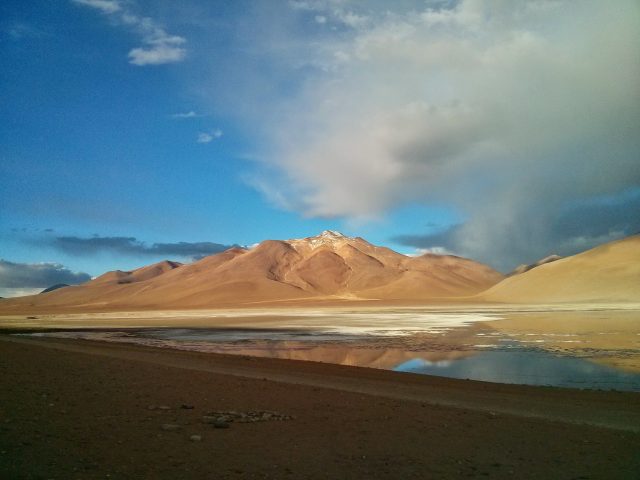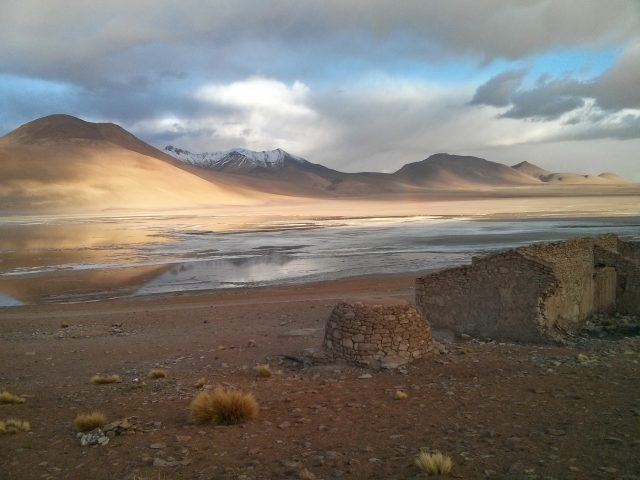I found myself riding a fairly beat-up motorcycle across desert highlands in Bolivia, a quote from Back to the Future 2 bouncing around in my head just as all of my gear was bouncing over rocks and grass balls. “Roads? Where we’re going, we don’t need roads!” The place I was in didn’t need me at all; its rocks and sands were entirely indifferent to me. The wind and rain would wash away my tracks in weeks, if not days. There were no other people in that valley, and even if there were, I wasn’t even on a track. This wasn’t a road. Nobody would come along and save me if I crashed. The vultures would pick my bones, and the wind would carry away my tattered clothing. The earth would eat the bike, with the rust blending into the red landscape.
The Thumper: A 2005 Kawasaki KLR 650
In early 2015, I decided I wanted to explore South America by motorcycle. Shipping one of my bikes would be expensive and time-consuming, and neither of the bikes I owned at the time was particularly appropriate. I decided to wing it and buy one once I arrived. A friend agreed to house-sit for me, and I hired someone to keep my small construction company going in my absence. While I didn’t have a huge budget, I figured I could stay on the road for about three months, give or take. Packing was a challenge as I didn’t know how much storage I’d have or what bike I’d be riding, so I kept things to a minimum: helmet, gloves, boots, riding pants, a jacket, clothes, sleeping bag, and a tent. I bought a ticket from Seattle to Lima, Peru, the ultimate destination to be determined.
Buying a motorcycle in Peru proved more of a challenge than I’d anticipated. Eventually, I found one for sale in a small northern beach town called Máncora. I flew from Lima to Piura to pick up the bike, a used 2005 Kawasaki KLR 650 I named Rocinante. The seller put me up for a few days with his extended family. I rolled out my sleeping bag on the roof of their house about two blocks from the Pacific Ocean. His father-in-law was a fisherman, and we ate ceviche fresh from the ocean.


After a few repairs and paperwork “adjustments” at the local internet cafe, I rode through the Angostura desert towards Chiclayo. Stopping by the side of the road for a smoke, I killed the engine of the KLR. The sky was clear and filled with stars as I sat there in silence—no traffic, no animals, no wind; just miles and miles of sand. Planning for this adventure didn’t prepare me for how it would feel to be so alone. Having grown up in the United States as a white male, there was always a safety net. The police would be there if needed. Ambulances would come. Clean water was everywhere, free for the taking. Not in this place. It felt humbling but also great to be independent. Nobody was waiting for me. I had no appointments to keep. Just an old thumper that I could point anywhere I wanted. Putting out my cigarette, I headed south.


The people I met in South America were generally friendly and treated me with great hospitality. I was welcomed into their homes, offered food to share, and helped with bike repairs. Before I left, many friends and associates cautioned me about traveling solo. I would be a target for bandits, they said. What if I crashed? Instead, the mere fact that I was alone made many folks eager to engage with me and created opportunities for connection.
After a couple of weeks on the Peruvian coast, I set out to cross the Andes like it was no big deal and something that could be done in a day. That was a mistake. Riding on the western side of the mountains, I found myself nodding off and had to pull over and do jumping jacks beside the road. The KLR was struggling in the thin air, and I couldn’t seem to get going faster than about 50 mph. Eventually, I pulled over onto the porch of a shuttered school to eat my lunch in the rain. It was getting very cold, and my desert gear was lacking. Still, I pressed on and finally emerged into the sunshine with a view of Lake Titicaca in the distance.
After checking my map, I decided to take a shortcut, heading southeast through some farmland toward Puno. As I rolled down red clay wagon tracks, I’d wave at the shepherds tending their flocks in the sun. They seemed to be going somewhere quickly. That’s when the storm clouds rolled in, and it started to pour buckets of freezing rain. The red clay turned to goo, fouling up my tires and transforming them into slicks.
The puddles filled, then it began to hail. I went down hard—a few times. There was no shelter. By dead reckoning, I pointed myself toward what had to be the main road and rode on. Soaked to the bone, muddy, tired from crossing the mountains, I finally made it to a town, checking into a crappy hotel and hanging my gear to dry. All I wanted was a hot shower, but there was no hot water. I put on dry clothes and got in bed, wrapping myself in every blanket I could find.
Bolivian Backroads
I crossed into Bolivia a couple of days later. The border at Desaguadero is marked by a bridge choked with people and moto-taxis. Those on foot skipped the border office, and if I’d known how I’d leave Bolivia a few weeks later, I would have as well. Aside from a question about why my registration was from Michigan (a forgery of a forgery) and my license from Washington, things went pretty smoothly. Finally, I asked a border official in my most pathetic Spanish, “Cual es necesito?” He eyeballed me for a minute, then stuffed the paperwork in my hands and told me I had 30 days to get the bike out of Bolivia.
My gas tank was getting low before I hit the border, but I’d been told gas was cheaper in Bolivia, so I waited. That proved to be a bad idea as gas stations were few and far between. I stopped at a military checkpoint on the way out of the border town and asked the guard how far it was to the next town with gas. It was really close, he said. Probably a 10-minute ride. Feeling relieved, I headed out of the dingy border town along Lake Titicaca. Right on schedule, and just after switching to my reserve fuel, was a town with two filling stations. Both were deserted. At another military checkpoint, I asked how far it was to the next town. “Close,” they said. When I pulled up to the pumps at the lone filling station in Tiwanaku, they were taped off. No gas. “Maybe tomorrow,” the gas attendant said. I parked beside a roadhouse and considered my options.
Next to that building was a circle of folks, mostly cab drivers, passing around a beer. One of the drivers, a stout woman with long black braids in colorful traditional dress, wandered over to me. How much gasolina did I need, she wanted to know. I said about 4 liters should do the trick. Would I pay 15 bolivianos per liter? Sure, I said. The cab drivers scrounged up a couple of empty soda bottles, jacked up one end of the cab, and proceeded to fill the bottles directly from the gas tank. We had a good laugh and shared a beer before I waved goodbye.
After exploring La Paz, I headed south toward Uyuni and the salt flats. There I met up with an Israeli and a German who were making their way south towards Patagonia after starting in Alaska. A route settled, we agreed to meet up at the turn-off from the paved road the next morning.
They left a bit before me as I was still trying to locate a chain guide (mine had fallen off somewhere in Bolivia). After searching all morning, I gave up and hit the road. When I arrived at our meeting point, they were nowhere to be found. I waited for a couple of hours and eventually decided they must have gotten tired of waiting for me and had already started across the mountains, so I began to ascend the foothills alone.


The bike was struggling, and every hour or so, I would get stuck in an old rut in the sand, hit a rock, and go down. The bike seemed to get heavier and heavier each time I picked it up and zip-tied it back together. At one point, I laid down to rest and heard the engine of a beat-up Land Cruiser. It was filled with a bunch of backpackers who seemed concerned at the sight of a motorcyclist lying in the sand. “Are you okay?” they asked. Besides a cracked rib or two, I was. They invited me to stay with them that night at a hostel beside a lagoon with natural hot springs. That sounded just fine to me. I arrived later that day for a well-deserved soak.
Wrapping up on the Chilean Coast
A couple of days later, I ran into the German and Israeli guys in San Pedro de Atacama, Chile, and we grabbed a beer to swap stories. It turned out that they had taken a wrong turn into the mountains and had had an even more difficult time getting across with their much larger bikes, a Super Tenere and R 1200 GS.
I felt like I’d accomplished something in the Andes and was content to travel down the Chilean coast from beach town to beach town, eventually arriving in Pucón. For the first time in weeks, I turned around and drove north. Seven weeks after my journey had begun, I bought a plane ticket home.


Solo adventure touring presents its own challenges and opportunities. The people I met along the way and my experiences wouldn’t have been the same if I’d been in a group. The bandits my mother was so worried about never materialized. Staying safe meant using common sense and avoiding areas of conflict and narco activity—not hard to do with a bit of planning. In the years that have passed since, not once have I regretted taking the trip. More often than not, I wish I was still riding that tractor of a bike somewhere in the Andes.

Our No Compromise Clause: We carefully screen all contributors to ensure they are independent and impartial. We never have and never will accept advertorial, and we do not allow advertising to influence our product or destination reviews.
Read: We Sold Our Home and Everything for a Motorcycle Trip by Lisa Morris


